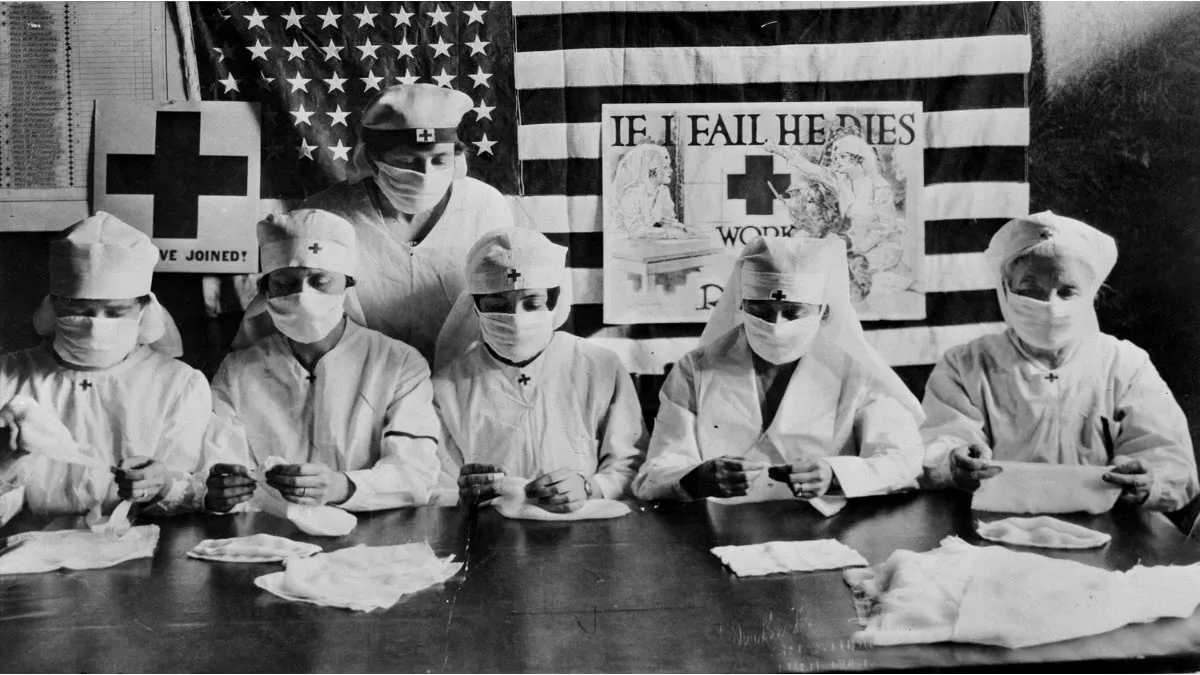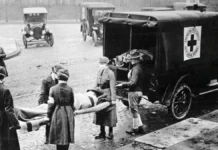The repercussions of pandemics on the economy and public health are phenomena that transcend time. When comparing the 1918 influenza and the current COVID-19 pandemic, striking similarities emerge, influencing not only the global economy but also the way osteopathic practitioners interact with their audiences. This in-depth analysis will highlight more parallels between these two crucial eras.
Economic Similarities
Historical introduction
The 1918 influenza and COVID-19 epidemics have had a profound impact on modern world history, leaving indelible imprints on public health and society in their respective eras.
The 1918 flu epidemic, also known as the “Spanish flu”, occurred in a particular context marked by the First World War. Declared in the middle of the Great War, it affected millions of people around the world. The rapid spread of the virus was favored by the movements of military troops, precarious living conditions and health challenges of the time. The 1918 flu primarily struck young, healthy adults, contributing to its devastating impact. The consequences were dramatic, with human losses estimated at between 50 and 100 million people worldwide, even surpassing the death toll from the battles of the First World War.
In comparison, the COVID-19 epidemic, triggered by the SARS-CoV-2 virus, emerged at the beginning of the 21st century, in 2019. Globalization and the increased interconnectedness of contemporary societies have facilitated the rapid spread of the virus to worldwide. The particular characteristics of COVID-19 include rapid, often asymptomatic transmission, which has complicated management of the pandemic. The consequences have been multiple, going beyond health impacts to encompass major economic, social and political disruptions. Containment measures, pressure on health systems and vaccination challenges have been at the heart of government and international responses.
In summary, these two pandemics marked their respective times, highlighting global public health vulnerabilities and underscoring the critical importance of international cooperation to address global health challenges.
Epidemiological similarities
The 1918 influenza and COVID-19 epidemics, although separated by almost a century, share some epidemiological similarities, while being influenced by the distinct social and scientific contexts of their respective eras.
- Transmission et Propagation :
- Speed of Spread: Both viruses have shown the ability to spread rapidly on a global scale. The 1918 flu took advantage of military troop movements during World War I, while COVID-19 spread rapidly due to frequent international travel and globalization.
- Human-to-human transmission: Both viruses are transmitted primarily from person to person, although the exact mechanisms of transmission differ. The 1918 flu was a type A (H1N1) virus, while COVID-19 is caused by a coronavirus, SARS-CoV-2.
- Risk Groups:
- Impact on Young Adults: A notable feature of the 1918 flu was its severe impact on healthy young adults, unlike seasonal flus which typically affect young children and the elderly. COVID-19 has also shown more severe effects among older adults, but has also affected younger adults, highlighting the variability in impacts across demographic groups.
- Risk factors: People with pre-existing medical conditions, such as cardiovascular disease and diabetes, have been identified as being more likely to develop severe forms of the 1918 flu. Similarly, COVID-19 has shown a increased severity in individuals with comorbidities.
- Control Strategies:
- Quarantine Measures: Both in 1918 and during the COVID-19 pandemic, quarantine measures were put in place to slow the spread of the virus. This included closing schools, limiting public gatherings and other social restrictions.
- Vaccination: Although vaccination was not an option during the 1918 flu, it has become a crucial part of the fight against COVID-19. Efforts to rapidly develop, produce and distribute vaccines have been a key challenge in mitigating the impact of the pandemic.
In conclusion, although the 1918 influenza and COVID-19 epidemics have significant differences in terms of viruses and social contexts, they share similarities in their rapid spread, impact on certain population groups, and use public health measures to mitigate the spread of the virus. Lessons learned from these experiences have helped inform current strategies for dealing with pandemics.
Global economic impact
The 1918 influenza pandemic had significant economic repercussions on a global scale, exacerbated by the context of the First World War. Here are some of the economic aspects of this period:
- Production and work disruptions: High rates of work absenteeism due to illness have led to major disruptions in production. Key industries, such as manufacturing and agriculture, have been severely affected.
- Decline in Productivity: The economy has experienced a decline in productivity due to the direct effects of the disease on the active workforce. Companies were forced to reduce production, leading to economic losses.
- Pressures on health systems and social services: The costs of caring for patients and implementing public health measures have placed financial pressure on governments and health systems.
- Specific sectors affected: Certain sectors, such as retail, transportation and tourism, have been particularly affected due to travel restrictions and concerns over contagion.
Lessons learned and echoes in the economic crisis induced by COVID-19:
- Economic interconnectedness: Both pandemics have highlighted the growing interconnectedness of global economies. Disruptions in one country have a domino effect on other nations, highlighting the importance of international cooperation and coordination of economic policies.
- Role of public health measures: Lessons from the 1918 flu influenced responses to the COVID-19 pandemic. Quarantine and social distancing measures, while imperfect, have been used to mitigate the spread of the virus and have had economic consequences, including business closures.
- Investments in medical research: The 1918 flu highlighted the importance of investments in medical research to understand and combat pandemics. These lessons have been put into practice in the rapid research and development of vaccines during the COVID-19 pandemic.
- Government Economic Responses: Governments have learned from past mistakes and responded proactively to the COVID-19-induced economic crisis by implementing economic stimulus measures, business aid programs and safety nets social.
In summary, the 1918 influenza pandemic left lasting economic scars, and lessons learned from that era have informed responses to the economic crisis caused by COVID-19. Governments and international institutions have sought to mitigate economic effects while taking steps to build economic resilience in the face of future health crises.
Social and health consequences
Social and health consequences of the 1918 flu
Medical Aspects:
- Severity and Mortality Rate: The 1918 flu was exceptionally severe, with a high mortality rate, particularly affecting healthy young adults. The virulence of the virus contributed to significant mortality.
- Lack of effective treatments: At the time, there was no flu vaccine, and treatments were limited. Public health measures focused primarily on isolation of the sick and quarantines.
- Health system overloads: Hospitals and health systems have been overwhelmed by the massive influx of patients. The lack of hospital capacity has contributed to the difficulty in caring for patients.
Social Aspects:
- Impact on daily life: Public health measures, such as closing schools and imposing quarantines, have had a significant impact on daily life. Public gatherings were restricted, and some areas experienced temporary business closures.
- Stigma and fear: The disease has often been surrounded by stigma and fear. Sufferers were sometimes ostracized, and the disease had long-term psychological effects on communities.
Health systems responses at the time: Health systems responses to the 1918 flu were limited by medical knowledge at the time. Preventive measures were mainly based on isolation of the sick, quarantine and advice on personal hygiene. Treatments were palliative, as there were no specific antiviral drugs.
Social and health consequences of COVID-19
Medical Aspects:
- Symptom severity and variability: COVID-19 has shown variability in symptom severity, ranging from mild to severe cases requiring respiratory support. Long-term complications (long COVID) were also observed.
- Vaccines and treatments: Unlike 1918, medical advances have enabled the rapid development of COVID-19 vaccines, with distribution on a global scale. Specific antiviral treatments and more advanced intensive care are also available.
- Pressure on healthcare systems: Modern healthcare systems have been put under pressure due to the high number of patients requiring care, including intensive care units and ventilators.
Social Aspects:
- Social distancing and behavioral changes: Social distancing measures, mask wearing and travel restrictions have had significant impacts on social behavior. Remote work and online education have become more common.
- Economic crisis: COVID-19 has triggered a global economic crisis with job losses, business closures and widening economic inequality.
Health systems responses today: Current responses include public health measures similar to those in 1918, such as quarantine, social distancing, and mask wearing. However, modern health systems have been able to leverage advanced medical research to develop vaccines, specific treatments and more sophisticated care protocols.
In comparison, the management of COVID-19 has benefited from past experience, leading to more rapid and globally coordinated responses. Rapid communication, technological advancements and international collaboration have played a crucial role in combating the COVID-19 pandemic.
Role of osteopathy in the management of pandemics
It is important to note that osteopathy is a complementary health care approach that focuses on the manual treatment of the musculoskeletal system and related disorders. Although some people claim to benefit from osteopathy for various conditions, it is crucial to emphasize that scientific evidence on its effectiveness in managing pandemics, including the COVID-19 pandemic, is limited.
In the context of pandemic management, osteopathy can potentially play a role in supporting general health and well-being, but it should not be seen as a substitute for conventional medical approaches recommended by health authorities. public.
Here are some points to consider:
- Stress and anxiety management: Osteopathy can help manage stress and anxiety by promoting muscle relaxation and improving blood circulation. Chronic stress can weaken the immune system, so any way to reduce stress can have a positive impact on overall health.
- Breathing support: Some osteopaths focus on the respiratory system, working on the mobility of the rib cage and improving respiratory function. This could potentially be beneficial for individuals with pandemic-associated respiratory illnesses.
- Strengthening the immune system: Although scientific evidence is limited, some argue that osteopathy may help strengthen the immune system by improving lymphatic circulation and promoting overall balance in the body.
It is important to note that these aspects are not specific to pandemic management and any potential benefit of osteopathy in this context is not widely supported by empirical data. Conventional medical approaches, such as vaccination, hygiene measures, and advice from public health authorities, remain key elements in the fight against pandemics.
Before resorting to osteopathy or any other alternative approach, it is recommended to consult a qualified health professional and follow the guidelines issued by the competent authorities.
Challenges and opportunities for osteopathic practitioners
Challenges encountered by osteopaths during the 1918 pandemic and comparison with COVID-19:
- Limitations of medical knowledge: During the Spanish flu pandemic in 1918, medicine had a limited understanding of viral pathogens and transmission mechanisms. Osteopaths, like doctors, faced challenges in treating a disease whose causes and spread were poorly understood. Today, although the understanding of viral diseases has advanced significantly, COVID-19 has presented similar challenges due to the novelty of the virus and the speed with which it has spread.
- Social distancing and lockdown constraints: Social distancing and lockdown measures put in place during the COVID-19 pandemic have hampered patient access to non-essential healthcare, including osteopathy. Osteopaths have had to deal with temporary office closures, travel restrictions and adjustments to treatment protocols to meet safety requirements.
- Health and Safety Concerns: Both in 1918 and today, healthcare professionals, including osteopaths, have faced potential risks to their personal health while treating patients during a pandemic. Limited availability of personal protective equipment and the need to take additional precautions were shared challenges between the two periods.
Emerging opportunities for osteopathic practitioners in the current context:
- Teleconsultation and online education: The pandemic has encouraged the adoption of new technologies, providing osteopaths with the opportunity to provide virtual consultations, share health advice online and deliver education sessions remotely. This broadens the reach of practitioners and facilitates access to care.
- Integration into holistic healthcare: Pandemics highlight the importance of a holistic approach to health. Osteopaths have the opportunity to strengthen their integration into health care by working in collaboration with other health professionals to offer complementary approaches.
- Strengthening prevention practices: Increased awareness of disease prevention has opened opportunities for osteopaths to focus on promoting healthy lifestyles, strengthening the immune system and preventing musculoskeletal disorders.
In conclusion, although the challenges osteopaths faced during the 1918 and COVID-19 pandemics have similarities, the emerging opportunities in the current context reflect technological advances and changes in the perception of health care. holistic. The adaptability of osteopathic practitioners to integrate these opportunities can strengthen their role in healthcare.
Challenges and opportunities for osteopathic practitioners
Challenges encountered by osteopaths during the 1918 pandemic and comparison with COVID-19:
- Communication Limitations: During the 1918 pandemic, osteopaths faced communication challenges due to the technological limitations of the time. The dissemination of crucial information was slower, making it difficult to coordinate care.
- Limited Access to Medical Resources: In 1918, access to medical resources, including personal protective equipment and specific treatments, was limited. Osteopaths faced difficulties in ensuring their own safety and that of their patients.
- Lack of standardized protocols: At the time of the 1918 pandemic, there was a lack of standardized medical protocols to deal with a crisis of this magnitude. Osteopaths had to improvise prevention and treatment measures.
- Isolation and social distancing: The need for isolation and social distancing during the 1918 pandemic could hinder the delivery of osteopathic care, as physical contact was central to the practice.
- Economic impact: The 1918 pandemic also had a major economic impact, which may have affected attendance at osteopathic practices due to the financial crisis and social disruption.
Challenges specific to COVID-19:
- Technology and Telepractice: Osteopaths have had to quickly adapt to the use of technology for telepractice, an option that was not available in 1918. This has created technological and ethical challenges.
- Strict health regulations: Modern health restrictions, including physical distancing measures and strict hygiene protocols, have forced significant changes to the way osteopaths practice their profession.
- Instant communication: The overabundance of instant and sometimes conflicting information can make it difficult to navigate for osteopaths, who must constantly adapt to new guidelines.
Emerging opportunities for osteopathic practitioners in the current context:
- Technology Integration: The pandemic has accelerated the adoption of telepractice and technological tools in the field of osteopathy, providing new opportunities to reach a wider audience.
- Continuing training and adaptation: Osteopaths have the opportunity to continually train to adapt to the new realities of public health and health protocols.
- Interprofessional Collaboration: In response to the challenges of COVID-19, osteopaths can seize the opportunity to strengthen collaboration with other healthcare professionals to ensure holistic and comprehensive care.
- Awareness and Education: Osteopaths can play a crucial role in raising public awareness of the benefits of osteopathy in maintaining physical and mental health, thereby strengthening demand for their services.
- Diversification of services: By expanding their skills and services, osteopaths can meet new patient expectations, such as stress management and overall well-being.
In conclusion, although the challenges faced by osteopaths during the 1918 pandemic and COVID-19 share some similarities, evolving technologies and approaches to health also provide opportunities for a more resilient and adaptable practice.
Future Perspectives
Lessons to improve preparedness for future crises:
- Adaptability and continuing education: Osteopathic practitioners can learn from past pandemics by emphasizing the importance of adaptability. Continuing education must include skills to quickly adjust to new health standards and emerging technologies.
- Telemedicine Integration: The COVID-19 pandemic has highlighted the importance of telemedicine. Osteopaths must invest in skills and infrastructure enabling the delivery of care remotely while maintaining ethical and quality standards.
- Interprofessional Collaboration: Establishing strong relationships with other healthcare professionals can improve coordination of care during a crisis. Osteopaths should participate in interprofessional networks and strengthen links with other practitioners for a comprehensive approach to health.
- Robust communication strategies: Practitioners must develop effective communication strategies to disseminate relevant information and reassure the public. Transparent communication about prevention measures and safety protocols can build patient confidence.
- Mental health management: Pandemic crises also affect the mental health of practitioners. Psychological support programs and resources for stress management should be integrated into training and professional practices.
Recommendations to strengthen the resilience of the osteopathic profession:
- Developing Contingency Plans: Practitioners should develop crisis-specific contingency plans, incorporating safety protocols, telepractice guidelines, and effective communication mechanisms.
- Investment in technology: Osteopaths must continue to invest in cutting-edge technologies, including solutions for telemedicine, electronic records management and virtual communication with patients.
- Crisis management training: Osteopath training programs should include modules on crisis management, covering aspects such as communication in times of crisis, problem solving and rapid adaptation to changing situations.
- Institutional support: Professional associations and institutions should provide institutional support to practitioners, including financial resources, updated guidelines, and psychological support programs.
- Promotion of research: Encouraging research in the field of osteopathy, with emphasis on aspects related to pandemics, can provide scientific bases to guide practices during public health crises.
- Participation in public health planning: Osteopaths can actively contribute to public health planning by participating in advisory committees, sharing their expertise on the management of musculoskeletal disorders and contributing to the design of care protocols.
In conclusion, learning from past pandemics and implementing recommendations to strengthen the resilience of the osteopathic profession is essential to effectively address future crises and ensure continuity of quality care.
References
Barry, J. M. (2004). The Great Influenza: The Story of the Deadliest Pandemic in History. Viking Penguin. Taubenberger, J. K., et al. (2005). The pathology of influenza virus infections. Annual Review of Pathology: Mechanisms of Disease, 3, 499–522. Côté, P., et al. (2020). Telehealth Services for Musculoskeletal Disorders. Journal of Orthopaedic & Sports Physical Therapy, 50(8), 447–450.]





















